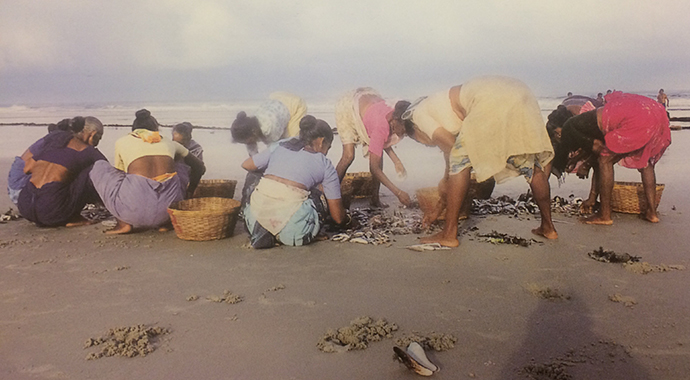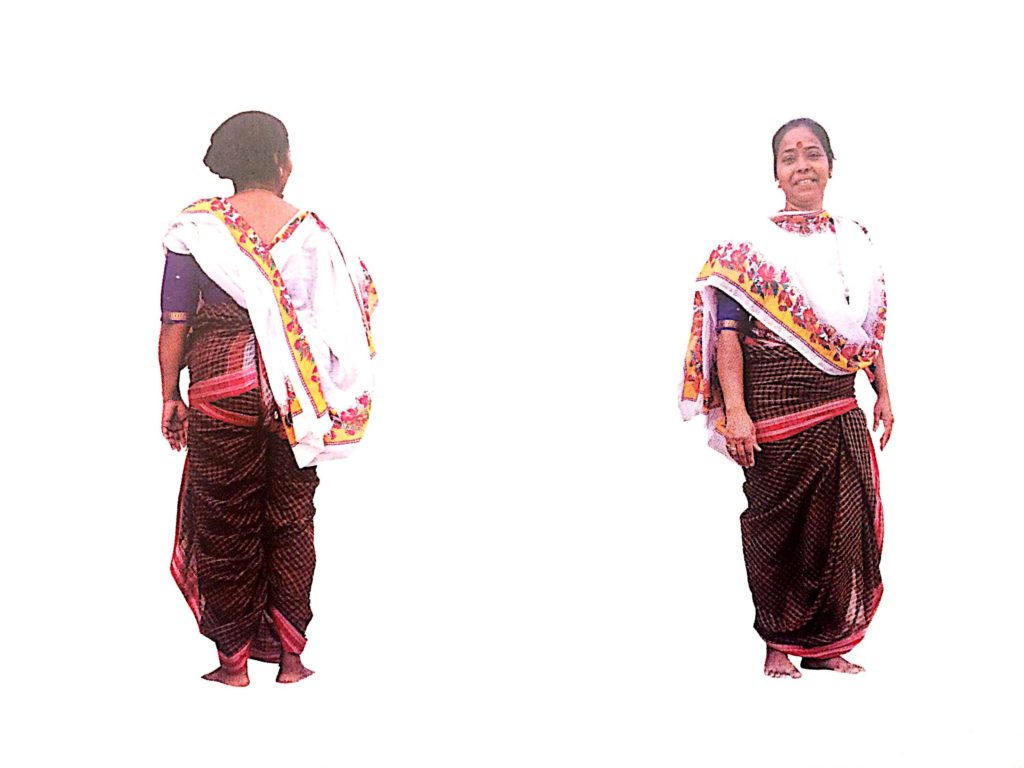As an unstitched piece of cloth, the sari and its drape has adapted to utility, climate and culture. This article explores five regional sari drapes which have historically enabled the work of the wearer: from a farmer, performer, fisherwoman, dancer to weaver.
Drape: Gobbe Seere
Origin: South and Central Karnataka
Above: The Gobbe drape image | Rta Kapur Chisti’s book Saris: Tradition and Beyond, published by Roli Books
Traditionally worn by Gowda landowners for the purpose of farming and other agricultural work, this drape is eight yards in length. A semi-formal style, it can be worn at home or out, as well as formal occasions, depending on the sari used.
Why it’s unique: This style is draped to form a waistband, which keeps the lower drape in position for the course of day. The drape also features a knot at the upper right shoulder which keeps the pallu in place.
Best sari or weave to drape it with: A medium range cotton or a medium silk sari as both can hold the form and shape.
Drape: Bootheyara
Origin: Bidar and Gulbarga districts of Karnataka
Above: The Bootheyara drape image | Rta Kapur Chisti’s book Saris: Tradition and Beyond, published by Roli Books
Draped from an eight yard sari, nomadic ceremonial performers are associated with this style.
Why it’s unique: This style consists of a two-piece drape. It can be worn as pants with plenty of leg mobility or as pants with a left shoulder upper drape. Depending on how the wearer chooses to drape it, this style may require a blouse; the shoulder drape can be used independently as a semi-shawl if a blouse is not worn.
Best sari or weave to drape it with: An ilkal sari of pure cotton with a pure silk border, a
silk-cotton blend or a light silk sari.
Drape: Koli
Origin: Coastal Goa
Above: The Koli drape image | Rta Kapur Chisti’s book Saris: Tradition and Beyond, published by Roli Books
This is a 9 yard sari drape worn by fisherwoman to enable greater lower limb mobility.
Why it’s unique: This drape is meant to cover the lower torso, and can double as both a petticoat and underwear. A separate upper drape can be worn in various ways depending on the formality of the occasion and season – for example, as a shawl in winter.
Best sari or weave to drape it with: Either a light cotton or light silk sari works best.
Drape: Surguja
Origin: North Chattisgarh
Above: The Surgaja drape image | Rta Kapur Chisti’s book Saris: Tradition and Beyond, published by Roli Books
Using a 5.3 yard sari, dancers of the Oraon community wear this drape for its functionality.
Why it’s unique: The loose lower drape, tucked away at the waist, keeps both arms and legs free for movement. The finished look features a “whirling drape” – with two loose end pieces in the front and back.
Best sari or weave to drape it with: A medium to heavy cotton sari.
Drape: Meher
Origin: West Orissa
Above: The Meher drape image | Rta Kapur Chisti’s book Saris: Tradition and Beyond , published by Roli Books
This drape requires a 5.7 yard sari and is worn by the weaving community.
Why it’s unique: This drape features a simple throw-over the shoulder style, but depending on the choice of sari, it could be worn for a formal occasion.
Best sari or weave to drape it with: This style would work well with a light cotton ikat sari or a light silk sari for a special occasion.









